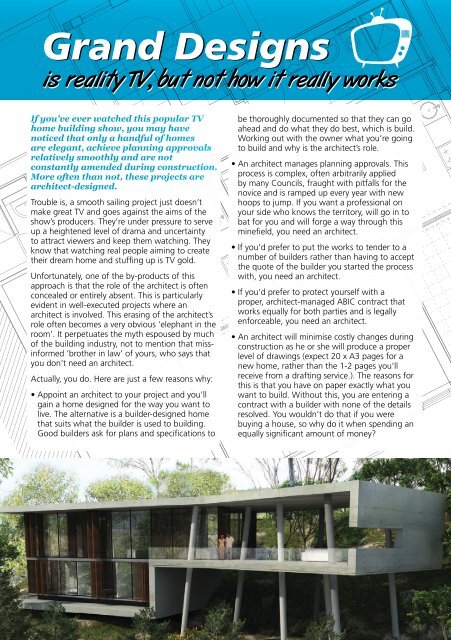DOGGIES MAGAZINE ISSUE 1
Create successful ePaper yourself
Turn your PDF publications into a flip-book with our unique Google optimized e-Paper software.
Grand Designs<br />
is reality TV, but not how it really works<br />
If you’ve ever watched this popular TV<br />
home building show, you may have<br />
noticed that only a handful of homes<br />
are elegant, achieve planning approvals<br />
relatively smoothly and are not<br />
constantly amended during construction.<br />
More often than not, these projects are<br />
architect-designed.<br />
Trouble is, a smooth sailing project just doesn’t<br />
make great TV and goes against the aims of the<br />
show’s producers. They’re under pressure to serve<br />
up a heightened level of drama and uncertainty<br />
to attract viewers and keep them watching. They<br />
know that watching real people aiming to create<br />
their dream home and stuffing up is TV gold.<br />
Unfortunately, one of the by-products of this<br />
approach is that the role of the architect is often<br />
concealed or entirely absent. This is particularly<br />
evident in well-executed projects where an<br />
architect is involved. This erasing of the architect’s<br />
role often becomes a very obvious ‘elephant in the<br />
room’. It perpetuates the myth espoused by much<br />
of the building industry, not to mention that missinformed<br />
‘brother in law’ of yours, who says that<br />
you don’t need an architect.<br />
Actually, you do. Here are just a few reasons why:<br />
• Appoint an architect to your project and you’ll<br />
gain a home designed for the way you want to<br />
live. The alternative is a builder-designed home<br />
that suits what the builder is used to building.<br />
Good builders ask for plans and specifications to<br />
be thoroughly documented so that they can go<br />
ahead and do what they do best, which is build.<br />
Working out with the owner what you’re going<br />
to build and why is the architect’s role.<br />
• An architect manages planning approvals. This<br />
process is complex, often arbitrarily applied<br />
by many Councils, fraught with pitfalls for the<br />
novice and is ramped up every year with new<br />
hoops to jump. If you want a professional on<br />
your side who knows the territory, will go in to<br />
bat for you and will forge a way through this<br />
minefield, you need an architect.<br />
• If you’d prefer to put the works to tender to a<br />
number of builders rather than having to accept<br />
the quote of the builder you started the process<br />
with, you need an architect.<br />
• If you’d prefer to protect yourself with a<br />
proper, architect-managed ABIC contract that<br />
works equally for both parties and is legally<br />
enforceable, you need an architect.<br />
• An architect will minimise costly changes during<br />
construction as he or she will produce a proper<br />
level of drawings (expect 20 x A3 pages for a<br />
new home, rather than the 1-2 pages you’ll<br />
receive from a drafting service.). The reasons for<br />
this is that you have on paper exactly what you<br />
want to build. Without this, you are entering a<br />
contract with a builder with none of the details<br />
resolved. You wouldn’t do that if you were<br />
buying a house, so why do it when spending an<br />
equally significant amount of money?

















